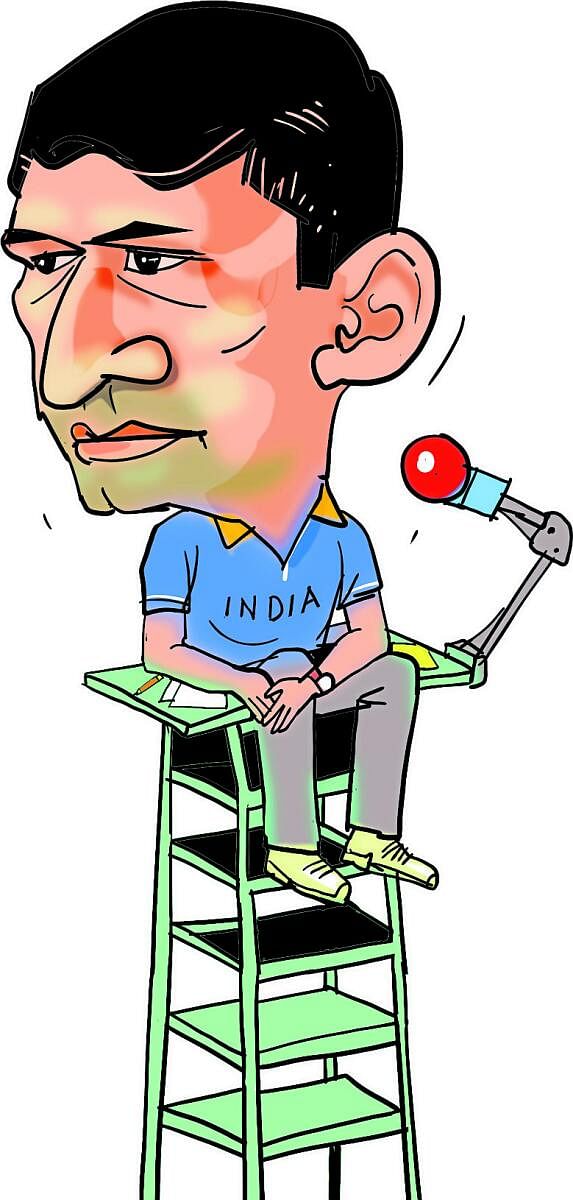
Credit: DH Illustration/Deepak Harichandan
Sitting on an elevation, the tennis chair umpire lords over anything and everything surrounding a tennis court. It is a taxing job, maintaining decorum and discipline both on and off the court and requires several hours of keeping a razor-eyed focus on the proceedings.
In a sport which brings together all kinds of characters, the role of the chair umpire assumes utmost importance in any scenario. That booming voice over the tannoy is not just responsible for reading out the scores, but for essaying crucial roles in tennis competitions worldwide.
While the officiating process is being professionalised with the incorporation of technology, chair umpires are tasked with key functions such as calling the scores during the match, enforcing the rules and managing the players.
“For me, getting exposed to it at the right age was important,” says the 36-year-old Sagar Kashyap, an International Tennis Federation (ITF) accredited umpire. “Seeing the Wimbledon chair umpires in their pristine coats served as an inspiration. I had a chance to officiate the 2015 Wimbledon men’s singles final between Roger Federer and Novak Djokovic. That was my first final, and it does not get any bigger than that,” says Sagar, who remains the youngest Indian to officiate in a Grand Slam.
Along with an Engineering degree from Vidya Vikas Institute of Technology, Sagar obtained his white badge in 2008 and bronze badge in 2016.
The typical career trajectory that culminates as a chair umpire begins as an on-court official.
“Line umpires graduate to chair umpires. Once you are a chair umpire, you can decide what you want to further pursue, akin to a student selecting which stream after 10th grade, and have the opportunity to branch out,” says another umpire from India, Supreeth, who has officiated in 15 Grand Slams.
When quizzed on the career opportunities, Sagar offers, “tennis is one of the more lucrative umpiring roles. It is, however, difficult to get into a higher rank and that is how it is structured by ITF. The process to go up the ladder is quite tedious, you start off with small tours and then move on to professional events. Once you are there, your ability to make it count matters most. Is it difficult? Yes. But we (him and Supreeth) are the prime examples. Both of us started from scratch but we are here now.”
There are three levels of training sanctioned by the ITF, and dependent on the region. Once you pass the second level, you receive a white badge and once you pass the third level, you receive a bronze badge. Bronze Badge holders get promoted to Silver and Gold, following an annual review conducted by the ATP and WTA.
Sagar and Supreeth explain the path up the levels, “Level one has national tutors, and it is extremely basic. Once you pass the national level, depending on abilities, you move on to level 2. You receive an ITF certification and are allowed to do professional events, the first doors open up here, but you are firmly in the ecosystem. Events are initially limited to the lowest rung as you slowly gain experience. Once you gain sufficient experience and your grades are satisfactory, you can attempt the bronze badge exam. That is when you become a part of the inner circle.
“I took part in a five-day ITF White Badge School workshop in Mumbai back in 2008. I became a Wimbledon line umpire in 2009, and there was no looking back from there,” says Sagar.
“There are five to six officiating courses in India that happen, the AITA upload these dates on website, based on requirement. So those wanting to become a chair umpire should keep a keen eye out for this,” Supreeth adds.
“There is a lot of grind involved. It can be getting assigned last minute, left to figure out transport, you are covered only to a certain extent. You need to figure out if you are in the stage of saving money or making money. Once you pass the grind, things get a lot more fruitful,” Sagar, who has sat on the high chair for 39 Grand Slams and two Olympics, reveals.
Earning a bronze badge is no mean feat. One has to clear a rigorous exam with a score over 90% and pass all the other tests that are associated.
While only a select few enjoy the perks associated with being at the Bronze level pedestal, a lot of determination and sacrifice is required. “It is not a lucrative career option right off the bat, you need extreme discipline and hard work. If you do progress to the bronze level and above, you are guaranteed a good career and get paid about $60,000 to $125,000 per year if you climb up the rungs from India,” Sagar weighs in.
Cut-off box - You need to have good decision making skills good communication and the levels of concentration need to remain high every second. You need to know when to switch on and off and also need to be flexible ready for an unexpectedcall-up. Sagar Kashyap Bronze-badge umpire
Cut-off box - I started as a ball-kid used to be a part of KSLTA and still played tennis. From a ball boy I graduated to a line umpire and then became a chair umpire. I received my white badge in 2008 and bronze badge in 2014. Supreeth Kadavigere Bronze-badge umpire